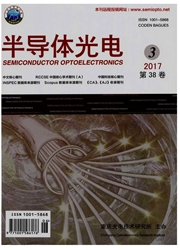

 中文摘要:
中文摘要:
采用金属有机化学气相沉积技术生长了GaN基多量子阱(MQW)蓝光发光二极管外延片,并采用高分辨率X射线衍射仪(HRXRD)和光致光谱仪(PL)表征晶体质量和光学性能,其他的光电性能由制成芯片后测试获得,目的是研究外延片p型AlGaN电子阻挡层Mg掺杂的优化条件。结果表明,在生长p型AlGaN电子阻挡层的Cp2Mg流量为300cm^3/min时,蓝光发光二极管获得最小正向电压VF,而且在此掺杂流量下的多量子阱蓝光发光二极管芯片发光强度明显高于其他流量的样品。因此可以通过优化AlGaN电子阻挡层的掺杂浓度,来显著提高多量子阱蓝光发光二极管的电学性能和光学性能。
 英文摘要:
英文摘要:
GaN-based multiple quantum well(MQW) light emitting diode (LED) epitaxial layers were grown by organometallic vapor-phase epitaxy. Crystal quanlity and properties were characterized by high-resolution X-ray diffraction(HRXRD)and photoluminescence(PL), and the optical and electrical properties were tested by chip tester, so as to study optimum Mg doping conditions of p-type AlGaN electron block layer in LED epitaxial layers. The results show that the minimum forward voltage (VF) was obtained at the Cp2Mg flow rate of 300 cm^3/min in depositing p-type AlGaN electron block layer. In addition, the luminescence intensity of the LED chip fabricated at the doping flow is found to be much higher than that in other doping flows. Thus the optimum Mg doping concentration was an effective method to improve the electrical and optical properties of blue LEDs.
 同期刊论文项目
同期刊论文项目
 同项目期刊论文
同项目期刊论文
 期刊信息
期刊信息
